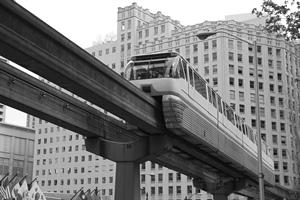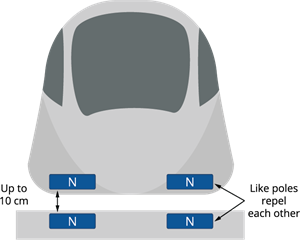PDF chapter test TRY NOW
When an electric current flows through an iron piece wounded by a coil, it behaves like a magnet. This phenomenon is known as electromagnetism.
A type of magnet that produces a magnetic field when an electric current flows through it is known as an electromagnet.
A type of magnet that produces a magnetic field when an electric current flows through it is known as an electromagnet.
The electromagnetic poles are changed when the direction of the current is changed.

A simple electromagnetic setup
Electromagnetic train:
A good application of an electromagnet is an electromagnetic train. This train works on the principle of magnetic levitation. Hence, it is also known as a suspension train or a flying train. This train does not use diesel or petrol. The magnetic attraction and repulsion properties are used to run these super-fast trains.
An electromagnetic train
Maglev train:
The short form of 'Magnetic levitation' is 'Maglev'. The Maglev train is an electromagnetic train. With the help of the force of attraction or repulsion properties of magnets, any magnetic object can be moved. This train mainly works on the repulsion property of a magnet.

Schematic representation of magnets in the maglev train
The bottom of the train and the rail track is attached with the like poles of the magnets. This attachment of like poles is to repel each other and lift the train from the track for at least \(10\ cm\).

Levitation of a maglev train
The sides of the track and the bottom sideway of the train is also fitted with the magnets to move the train. The flow of the electricity controls the motion of the train.
Advantages:
- The train travels at a high speed of \(300\ km\ per\ hour\) and can even reach up to \(600\ km\ per\ hour\) since there is no friction.
- No noise is produced.
- The train consumes less energy compared to the other normal trains.
- The train is eco-friendly as it does not pollute the environment.
Countries with Maglev trains:
These trains are used as public transport only in China (Shanghai Maglev train), Japan (SC Maglev) and South Korea (KTX). There are some possibilities of introducing these trains in India. The considerable proposal for the routes is Mumbai - Delhi, Mumbai - Nagpur, Chennai - Bangalore - Mysuru.
These trains are used as public transport only in China (Shanghai Maglev train), Japan (SC Maglev) and South Korea (KTX). There are some possibilities of introducing these trains in India. The considerable proposal for the routes is Mumbai - Delhi, Mumbai - Nagpur, Chennai - Bangalore - Mysuru.
